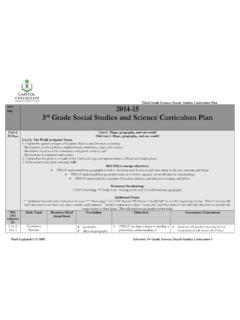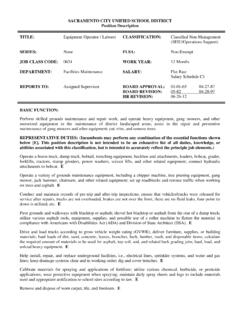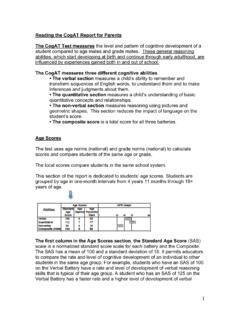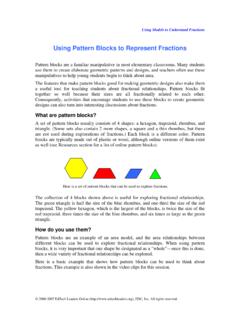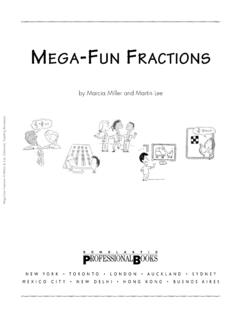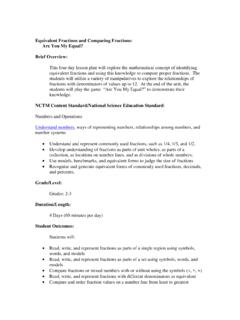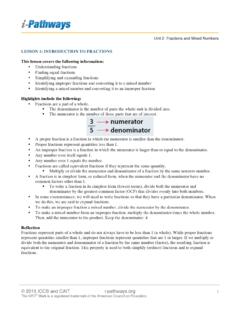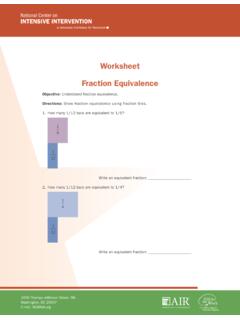Transcription of 5th Grade Fractions Unit of Study
1 unit of Study DRAFT Fractions Grade : 5 Topic: Number and Operations: Fractions Length of unit : 12-15 days Focus of Learning Common Core Standards: Standards for Mathematical Practice: Use equivalent Fractions as a strategy to add and subtract Fractions . 1. Make sense of problems and Add and subtract Fractions with unlike denominators (including mixed persevere in solving them. numbers) by replacing given Fractions with equivalent Fractions in such a way 2. Reason abstractly and quantitatively. as to produce an equivalent sum or difference of Fractions with like 3.
2 Construct viable arguments and denominators. For example, 2/3 + 5/4 = 8/12 + 15/12 = 23/12. (In general, a/b critique the reasoning of others. + c/d = (ad + bc)/bd.) 4. Model with mathematics. Solve word problems involving addition and subtraction of Fractions 5. Use appropriate tools strategically. referring to the same whole, including cases of unlike denominators, , by using visual fraction models or equations to represent the problem. Use 6. Attend to precision. benchmark Fractions and number sense of Fractions to estimate mentally and 7.
3 Look for and make use of structure. assess the reasonableness of answers. For example, recognize an incorrect 8. Look for and express regularity in result 2/5 + 1/2 = 3/7, by observing that 3/7 < 1/2. repeated reasoning. Supporting Standards: Represent and interpret data. Make a line plot to display a data set of measurements in Fractions of a unit (1/2, 1/4, 1/8). Use operations on Fractions for this Grade to solve problems involving information presented in line plots. For example, given different measurements of liquid in identical beakers, find the amount of liquid each beaker would contain if the total amount in all the beakers were redistributed equally.
4 Enduring Understanding(s): Students will understand that . Fractions extend the number system's complexity and applicability in problem-solving. Fractions are numbers that express relationships between the part and the whole. identifying the whole or unit is critical for interpretation of Fractions . Fractions may represent division with a quotient less than one. Equivalent Fractions represent the same value The more equal-sized pieces that form a whole, the smaller the pieces of the whole become. With unit Fractions , the greater the denominator, the smaller the piece is.
5 Comparisons between Fractions are valid only when the two Fractions refer to the same whole. Guiding Questions: These questions will guide student inquiry. What is a fraction? How are Fractions similar to whole numbers? How can you use what you know about whole number operations to solve problems with Fractions ? How does changing the number of the fractional parts help to solve problems with a different number of fractional parts? How is equivalence maintained when adding or subtracting Fractions with different-sized parts? Where do we find Fractions in the real world?
6 When is it appropriate to estimate when solving problems with Fractions ? How will you justify your answer? What are ways you can use Fractions to solve problem situations? Student Performance Knowledge: Students will understand/know Application: Students will be able to . Fractions can be represented as part of whole. Create equivalent Fractions . When comparing Fractions , the whole must be the same. Use a common whole to add Fractions . Fractions can be represented as part of a set Reduce or rename Fractions to solve problems. Fractions can be represented as an area model Reason about size of the parts based on denominator.
7 Fractions can be represented as a number on a number Use models to represent Fractions and solve problems. line. Use benchmark Fractions to reason about Fractions . th 5 Grade Fractions Number and Operations - Fractions Fractions can be represented as a measure. Use proportional reasoning. A fraction is another representation of division. Read data on line plot and use the information to solve Conceptual understanding of numerator and problems denominator. Write measurements in Fractions of a unit Many Fractions can represent the same value: 1/2=2/4=3/6.
8 Units can only be combined with like units ex: common denominator: halves + halves, fifths+ fifths, feet + feet. Adding and subtracting Fractions with unlike denominators; the numerator tells the number of parts and the denominator tells the type of parts Mixed numbers represent a whole number plus a fraction less than one Assessments (Attached). Pre-Assessment: . Formative Interim Assessment: Mid- unit Check (Use after Lesson 5 ). Suggested Formative Assessments: o Illustrative Mathematics: Naming the Whole for a Fraction (Use after Lesson 1).
9 O Illustrative Mathematics: Do These Add Up? (Use after Lesson 1). o Illustrative Mathematics: Finding Common Denominators to Add (Use after Lesson 5,6). o Illustrative Mathematics: Mixed Numbers with Unlike Denominators (Use after Lesson 6). o Smarter Balanced Sample Item: (Use after Lesson 6). o Smarter Balanced Sample Item: (Use after Lesson 6). o Illustrative Mathematics: Finding Common Denominators to Subtract (Use after Lesson 7,8). o Illustrative Mathematics: Making S'Mores (Use after Lesson 8). o Smarter Balanced Sample Item: (Use after Lesson 8).
10 O Illustrative Mathematics: Jog-A-Thon (Use after Lesson 9). Post Assessment: (Culminating Task). CORE: Jim's Trip to Disneyland Learning Experiences (Lesson Plans Attached). Days Lesson Sequence Materials Pre-Assessment: Suggested Formative Lesson 1: identifying and Comparing Fractional Representations Assessment: Illustrative Mathematics: of the Whole Naming the Whole for a Students will know . Fraction Fractions can be represented as part of whole. Illustrative Mathematics: Fractions can be represented as part of a set Do These Add Up?

